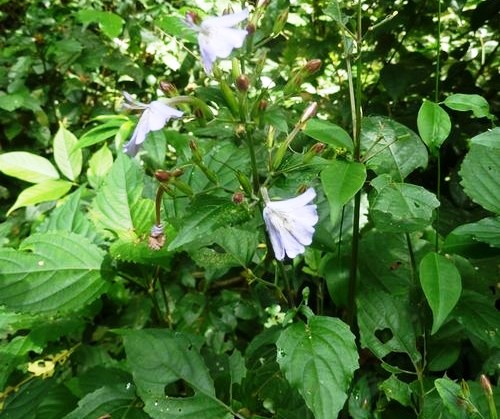Eremomastax speciosa

|
|
Eremomastax speciosa Common Names: African Blood Tonic, Blood Spinach,
Congo Spinach Scientific
Classification Kingdom: Plantae Phylum: Angiosperms Class: Monocots Order: Lamiales Family: Acanthaceae Genus: Eremomastax Species: E. speciosa Binomial Name: Eremomastax speciosa (Hochst.) Cufod. Synonyms: Eremomastax polycephala (Baker) Cufod., Justicia speciosa Hochst. Morphological Description Eremomastax speciosa is a perennial herbaceous plant, typically 1–1.5 m tall,
occasionally reaching 2 m. Key features include: · Stems: Quadrangular, green, slightly succulent, sprawling or erect · Leaves: Opposite, ovate to lanceolate, 5–15 cm long, bright green,
glossy · Flowers: Red to orange-red, tubular, 2–3 cm long, in dense terminal
clusters · Fruit: Small capsules, 5–7 mm, containing 2–4 seeds Its vibrant flowers
attract pollinators like bees and butterflies (Heine, 1966). Distribution and Habitat Eremomastax speciosa thrives in: · Native Range: West and Central Africa (Nigeria, Cameroon, Ghana, DR Congo) · Habitat: Damp areas—riverbanks, swamps, forest clearings, roadsides;
0–1,200 m altitude · Climate: Tropical, humid, 25–32°C, rainfall 1,500–3,000 mm · Soil: Moist, loamy, pH 5.5–7 Ethnopharmacology Eremomastax speciosa is a staple in African traditional medicine, with validated
uses: Eremomastax speciosa, a
medicinal plant native to tropical Africa and particularly common in Central
and West Africa, is widely used in traditional medicine for its diverse
therapeutic properties. It is used to treat gastrointestinal disorders like
diarrhea, dysentery, and stomach ulcers, as well as respiratory conditions,
wounds, and inflammatory diseases. Scientific studies have confirmed its
antimicrobial, anti-inflammatory, antidiarrheal, antispasmodic, and antioxidant
properties. It has also been shown to have hepatoprotective effects, helping to
protect the liver from damage, and may exhibit antifertility and antimalarial
activity in certain traditional uses.The plant is sometimes used as a uterine
tonic and is also employed in managing fevers, pain, and infections. Although
it holds significant promise as a natural remedy, more clinical studies are
needed to fully validate its efficacy, determine safe dosage ranges, and
understand potential side effects in humans. · Fever/Malaria: Leaf decoction in Cameroon; antipyretic in rats (40% at 200
mg/kg) (Amang et al., 2017). · Coughs: Leaf infusion in Nigeria; expectorant properties noted
traditionally (Okokon et al., 2007). · Hypertension: Leaf extract in Cameroon; reduces blood pressure. · Gastrointestinal (Diarrhea/Dysentery): Leaf decoction in Nigeria; antisecretory
effect (60% at 400 mg/kg) (Tan et al., 1996). · Anemia/Blood Tonic: Leaf juice in Cameroon; increases
hemoglobin (10% at 200 mg/kg) (Okokon et al., 2007). · Anti-inflammatory: The extract (25 to 400 μg/ml) demonstrated
potent antioxidant activities in both the 2,2-diphenyl-1-picrylhydrazyl and
ferric reducing antioxidant power assays. The E. speciosa extract caused
significant (P < 0.05) anti-inflammatory and antinociceptive activities in
the extract treated groups when compared to rats that received distilled water.
The optimal activities of the extract were produced at the dose of 100 mg/kg (Onoja
et al., 2017b). · Antimicrobial: Leaf extract in Cameroon; active against H. pylori (MIC 0.5 mg/mL) (Siwe et al., 2020). ⚠ Toxicity Profile: No acute toxicity at <500 mg/kg (LD₅₀ >
2,000 mg/kg in rats); mild gastrointestinal irritation possible at high doses
(Siwe et al., 2020). Additional Information · Local Uses: Leaves cooked as a vegetable in Nigeria and Cameroon; rich
in iron (PROTA, 2019). · Research Potential: Studied for anti-ulcer, antihypertensive,
and antimalarial drugs (Siwe et al., 2020). · Ecological Role: Stabilizes soil in wetlands; supports
pollinator biodiversity (Heine, 1966). References
External Links More Pictures |
|
| Compounds of Eremomastax speciosa |
|
| References |